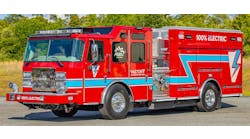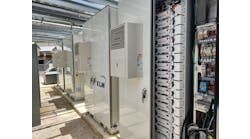You might say the world’s just catching up to Russelectric. Long before microgrids were called microgrids, the Massachusetts-based company offered the technology.
“We have been building microgrid and distributed energy controllers and systems for 50-60 years, they just weren’t calling them that,” said John Stark, Russelectric’s marketing communications supervisor. “The words distributed energy and microgrids have only come into common usage in the last 10 years or so. We didn’t use those words to describe these projects, but we essentially built systems with the same functionality and the same capabilities.”
The only real difference now is the addition of solar and energy storage, “and for us those are just additional power sources and another asset that needs control,” he said.
Today, Russelectric demonstrates its mastery over the contemporary microgrid at its corporate headquarters in Hingham, where it operates a hybrid solar-plus-storage and diesel microgrid, commissioned in 2017’s third quarter.
Microgrid Knowledge recently accepted an invitation from Russelectric to tour the facility.
A microgrid in the true sense of the word, the corporate installation can automatically and seamlessly disconnect from the local utility grid and supply power to meet critical needs at the company’s Hingham headquarters in the event of a grid outage.
At the same time, the project acts as a demonstration for potential customers to tour. Linked to a simulated load bank, the microgrid can operate in virtual scenarios capable of simulating a combination of operating conditions.
Under normal, grid-connected conditions, the hybrid microgrid optimizes generation and dispatch from its solar PV and battery energy storage systems, thereby reducing utility bills, greenhouse gas emissions and other negative environmental and health impacts.
Russelectric microgrid at-a-glance
- 250 kWdc/250 kWac of solar PV
- 69 kW/137 kWh of lithium-ion battery energy storage
- 900 kW of back-up diesel generation.
All these elements, along with network-connected, automated switch-gear and electrical equipment are coordinated, optimized and administered via the Russelectric Distributed Energy Controller (RDEC) integrated microgrid hardware and software control solution.
Development timeline
- Manufacturing of all the components ATS’ and switch-gear (475 hours
- Engineering design time including schematics, manuals, panel design, PLC (Programmable Logic Controller) and HMI (Human Machine Interface) programming (450 hours)
- Shutdowns, cut-overs, ‘energization,’ testing and commissioning to get it all up and running (1025 hrs)
Tailoring microgrids to specific operating environments
Russelectric’s hybrid microgrid differs in several, notable respects from the on-site energy services systems the company has installed for customers across the U.S. over the years, said Edmund Malley, Russelectric vice president, technology and innovation
For one thing, Russelectric has provided microgrid control systems for installations with as much as 50 MW of capacity. Several other differences revolve around the energy requirements specific to the company’s Hingham headquarters, Russelectric’s desired functionality and how those relate to the grid services provided by its local utility, the customer-owned Hingham Municipal Lighting Plant.
Hingham has been 100 percent supportive of Russelectric’s microgrid project, to the degree that it took just one day for the municipal utility to approve the project, Malley said.
On the other hand, as a municipal utility, Hingham is not required to offer net metering or otherwise enable customers to sell their on-site energy. As a result, Russelectric’s microgrid does not make use of economic or emissions reductions optimization models.
“We don’t have financial or emissions optimization in this particular instance of the RDEC (Russelectric Distributed Energy Controller) system for a number of reasons. First, we’re tied into Hingham Municipal Lighting and they don’t provide the information we need to carry out those sorts of operations. Secondly, the diesel generator we’re using in this system, at least for the present, is old and we can’t get the data required,” said Tim Kelley, Russelectric director, renewable & storage solutions.
However, Russelectric can — and has — provided advanced microgrid optimization for its customers, among them data centers.
“If we were deploying RDEC for a new installation, let’s say in California, then we absolutely have the capability to put in the financial optimization,” Kelley said. “We can set up the control system so that you have financial indicators, time-of-use pricing, hourly and day-ahead energy forecasts, what you want to do during on-peak versus off-peak, your trigger points, etc. Then we deploy the microgrid resources to execute in that way.”
Opportunity for growth
Looking ahead, Russelectric management sees more and more opportunities opening up in the coming years for behind the meter microgrids and distributed energy facilities.
Having installed tens of thousands of emergency, back-up power generators and distributed energy systems across the U.S., Russelectric sees itself as uniquely positioned to take advantage of today’s microgrid trends.
‘We’ve been working with all the emergency generator manufacturers for 50-60 years. That’s everybody, gas turbines, etc. We have all that, and we also have a lot of experience integrating power resources, whether that means working with local utilities or multiple equipment and device suppliers,” Malley said.
He noted that much attention is being devoted to the critical role microgrid controllers play within the overall context of project development, and justifiably so. However, there is more to a fully, well functioning microgrid, he said.
“If you’re working on the customer side of the meter, you need a lot more than the microgrid controller, you need all the microgrid equipment,” he said. “We see people from the inverter world offering different solar inverters, or battery storage vendors with inverters that don’t do everything it takes. Even if they have control signals, you still need automated electrical switch-gear, you need automated transfer switches, etc.”
Mission-critical customers
Russelectric has traditionally focused on manufacturing electrical equipment and providing distributed energy and emergency power systems for mission-critical facilities – hospitals, health care centers, data centers and government facilities, as well as some industrial sites. That will continue as Russelectric works to build its presence in the microgrid market.
“Practically all of them already have thermal generating systems. The activity and focus going forward would be on how they could best incorporate solar-plus-storage, upgrading their systems so that they have more renewable and sustainable, intermittent resources that can be patched into a mission-critical power system,” Kelley said.
In parallel with that, Russelectric aims to expand its microgrid offerings for large commercial or industrial customers.
“We’re probably not a good fit for a small facility that’s looking for a relatively simple energy services appliance. However, if you’ve got multiple, controllable loads and/or generation assets with different characteristics that have to be controlled and optimized, that’s where we tend to shine,” Malley said.
Stark added: ”Even in our traditional niche, we’re uniquely positioned – we’re a privately-held company heavily weighted towards engineering with a vertically integrated factory and comprehensive lines of electrical products and services. Taking all of those points into consideration I believe gives us tremendous prowess in carrying forward this new concept.”
Tour operating microgrids and those in development at Microgrid 2018 in Chicago May 7-9.







